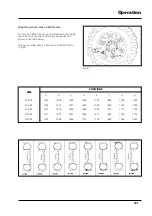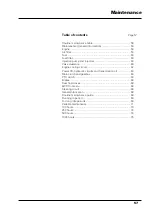
46
Operation
The tyres are filled to the three-quarter mark when
water escapes from the small tube (4) if this is posi-
tioned completely downwards. To add less water, i.e.
obtain a lower weight, turn the wheel so that the valve
is in a more downward position.
Tighten the union on the valve casing again and inflate
the tyre with air until obtaining the prescribed pressure.
Take the following precautions when preparing the
water-calcium chloride mixture (antifreeze solution for
the cold season):
pour the necessary amount of water in a vessel and
then pour in calcium chloride until the established
quantity has been reached. Never ever pour water
on to the calcium chloride as this would cause a
violent reaction;
only use the solution after it has completely cooled.
To limit the acicity, add 1% of soda in proportion to
the calcium chloride used;
after inflating the tyre, thoroughly rinse any metal parts
that may have been wetted with this corrosive solu-
tion, with water.
How to deflate the tyres.
Jack up the tyre in question and set it with its valve
pointing downwards.
Unscrew the mobile union of the valve and allow the
water to drain from the tyre.
Tighten the relative union in to the valve housing and
place the tube (4) in contact with the tyre.
Blow in pressurized air through the union (2): the
remaining water will drain through the tube (4).
Remove the union (3), replace it with the valve
retainer and then inflate the tyre.
NOTE
- Never use ballasting systems differing from the
ones indicated above
.
Fig. 26
Indicative layout for water ballasting:
1) Valve housing;
2) Water tube union;
3) Special fitting to pour in and drain out the water;
4) Air bleeding tube.











































